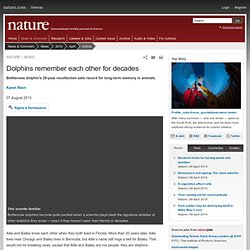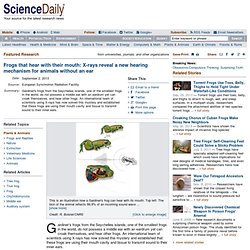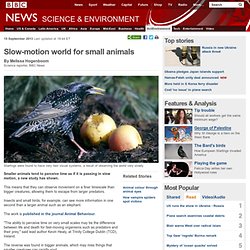

Experts decode secret polarisation language › News in Science (ABC Science) News in Science Wednesday, 18 December 2013 Anna SallehABC Polarising shrimps Scientists have decoded a secret animal language that is based on the polarisation of light.

The language, like colours, is probably being used to covertly communicate with mates or rivals, says animal neuroscientist Professor Justin Marshall of the Queensland Brain Institute. "We are interpreting this secret language of polarising, and placing it into colours that humans can understand," says Marshall, who is co-author of a study reported today in the journal Proceedings of the Royal Society B.
Animals like ants, bees and fish are known to use their ability to detect polarised light in the sky as a means of navigation. But in the past year, scientists have discovered animals use polarised light for communication as well. Butterflies Remember Caterpillar Days. The metamorphoses that caterpillars undergo rank among the most radical transformations in the animal kingdom.

So it's rather amazing that a butterfly or moth can remember things from its caterpillar days. Amazing, but true, a new study finds. Robins can literally see magnetic fields, but only if their vision is sharp. Some birds can sense the Earth’s magnetic field and orientate themselves with the ease of a compass needle.

This ability is a massive boon for migrating birds, keeping frequent flyers on the straight and narrow. But this incredible sense is closely tied to a more mundane one – vision. Thanks to special molecules in their retinas, birds like the European robins can literally see magnetic fields. The fields appear as patterns of light and shade, or even colour, superimposed onto what they normally see. Katrin Stapput from Goethe University has shown that this ‘magnetoreception’ ability depends on a clear image from the right eye. Dolphins remember each other for decades. Allie and Bailey knew each other when they both lived in Florida.

More than 20 years later, Allie lives near Chicago and Bailey lives in Bermuda, but Allie’s name still rings a bell for Bailey. That would not be breaking news, except that Allie and Bailey are not people: they are dolphins. Fairy-wren babies need password for food. It's always a good idea to listen to your mother, but that goes double for baby fairy-wrens even before they are hatched.

If those fairy-wren babies want to be fed, they need to have a password -- a single unique note -- taught to them by their mothers from outside the egg. The nestlings incorporate that password right into their begging calls, according to researchers who report their discovery online on Nov. 8 in Current Biology, a Cell Press publication. Frogs that hear with their mouth: X-rays reveal a new hearing mechanism for animals without an ear. Gardiner's frogs from the Seychelles islands, one of the smallest frogs in the world, do not possess a middle ear with an eardrum yet can croak themselves, and hear other frogs.

An international team of scientists using X-rays has now solved this mystery and established that these frogs are using their mouth cavity and tissue to transmit sound to their inner ears. The results are published in the Proceedings of the National Academy of Sciences on September 2, 2013. The team led by Renaud Boistel from CNRS and University of Poitiers, comprised also scientists from Institut Langevin of ESPCI ParisTech, the Laboratoire de Mécanique et d'Acoustique in Marseilles, the Institute of Systems and Synthetic Biology at the University of Evry (France), the Nature Protection Trust of Seychelles, and the European Synchrotron ESRF in Grenoble. The way sound is heard is common to many lineages of animals and appeared during the Triassic age (200-250 million years ago). Mantis shrimp have the world's best eyes—but why?
As humans, we experience an amazing world of colour, but what can other animals see?

Some see much more than us, but how they use this vision is largely unknown. We see what we see because our eyes have three photoreceptors, red, green and blue. Our vision is good compared to dogs which have only two photoreceptors (green and blue), but is nothing compared to many birds who have four photoreceptors: ultraviolet (UV) as well as red, green and blue. The addition of a UV photoreceptor is hard to imagine, but if we consider invertebrate vision it gets even more mind-boggling. Butterflies have five photoreceptors, providing them with UV vision and an enhanced ability to distinguish between two similar colours. Slow-motion world for small animals. 15 September 2013Last updated at 19:44 ET By Melissa Hogenboom Science reporter, BBC News.

New Infrared Camouflage Coating Created from Squid-Derived Compound. A team of researchers led by Dr Alon Gorodetsky of the University of California, Irvine, has developed a tunable biomimetic infrared camouflage coating inspired by pencil squids.

The scientists have developed a new camouflage using reflectin, a compound derived from Loliginidae, also known as pencil squids or calamari. The image shows two pencil squids Sepioteuthis sepioidea. Image credit: Jim Lyle / California State University Dominguez Hills. New Snail Species with Semi-Transparent Shell Discovered in Croatia. Great White Shark uses Fat Stored in Liver to Make Non-Stop 2,000+ Mile Trips : Science. Jul 18, 2013 10:15 AM EDT By Russell Westerholm, UniversityHerald Reporter (r.westerholm@universityherald.com) For the first time, scientists have proved that sharks store large amounts of fat before long journeys, the Monterey Times reported.

In a study published Wednesday, Hopkins Marine Station in Pacific Grove researchers discovered that sharks share that characteristic with many birds, whales and other creatures. Like Us on Facebook The great white shark will store fat in the liver and use it for energy as it moves along on its trek. This has been the first time any study has found sharks to be capable of doing this. Butterflies remember a mountain that hasn't existed for millennia.